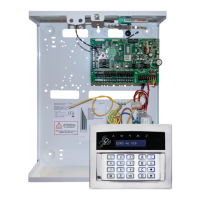Page: 20
Confirm Time Time period during which a second activation must occur to qualify as a ‘sequentially
confirmed’ alarm. NOTE: BS8243 specifies a confirm time between 30 and 60
minutes. This can also be used in conjunction with testing an omit signal.
1–99
minutes
HU Confirm
Time
Time period during which a second activation on a hold alarm must occur to qualify as
a ‘sequentially confirmed’ alarm. NOTE: BS8243 specifies a confirm time between
eight and 20 hours. This can also be used in conjunction with testing an omit signal.
8 – 20
hours
Strobe Time The duration of time the strobe output remains live after the bell time ends (‘99’
means endless).
0-99
minutes
Re-Arm No. The number of times the system re-arms after the bell time ends. Re-arm number
applies to each area and does not affect emergency alarms (‘9’ = ‘always re-arm’).
0-9
AC Signal
Delay
The time delay before the mains failure or technical alarm is notified. (NOTE: Setting
‘250’ = never alarms). System changeover to battery supply and associated visual
alert indication is always immediate.
Some ATE imposes a randomised delay in notifying a mains fail. This should be taken
into account when setting this timer.
0-250
minutes
Settle The time between final exit input closing and the system setting. When a code is
entered to set the system the exit time will start, but the system will not set until it
sees the final exit door open and close and then waits the duration of the settle time.
0-255
seconds
Double Knock The length of the filter period applied to inputs with the ‘Double Knock’ input
attribute.
0-75
seconds
Pre-Alarm Delays ‘Intruder’ output signals if the entry time has started. Pre-alarm time must be
set for at least 30 seconds to comply with PD6662
0–255
seconds
Comms Fault
Delay
Duration of ‘Comms Fault’ before the ‘Comms Fault’ alarm is triggered. NOTE: In the
case of devices connected via the ATE pins, this time is additional to that already
applied by the ATE.
0–250
minutes
Set Fail The time after which the ‘Set Fail’ operation will be invoked if the exit procedure is not
completed.
5–255
seconds
Guard Code
Alarm
Minimum time an alarm must have existed before a
‘Guard’ code will be accepted to unset.
0-10
minutes
Fire Siren
Time
The cut off time for the fire alarm (‘99’ means endless). 1–99
minutes
Set Fail
Warning
The time for which a set fail warning will be present.
0–99
minutes
Input NAT
Days
This ‘None Activity Timer’ (NAT) works in conjunction with the Input Attribute ‘Monitor
Activity’ and defines the time after which the ‘Zone Activity Fl’ output will be triggered
when ‘Monitor Activity’ is enabled for an associated input.
0-14
days
Input NAT
Hours
Used in conjuction with ‘Input NAT Days’ to give a total time defined in days and
hours combined (e.g. 0 days, 1 hour or 14 days, 23 hours etc.)
0-23
hours
Wireless
Supervision
Time
This option is only applicable if wireless devices are installed. It is the time window
before a wireless supervision fault will be signalled, for example: if the time is set for
two hours, then any device that does not communicate with the control panel within
that period will cause a supervision fault. This must be programmed to two hours or
less for compliance to EN50131.
0-99
hours
Wireless
Jamming
Time
This option is only applicable if wireless devices are installed. It is the time window
that a fault would display if a wireless device had its signal ‘blocked’, for example: if
the time is set to 30 seconds, then if a wireless device is ‘jammed’ longer than 30
seconds a fault will be displayed. This must be programmed to 30 seconds or less
(but not zero) for compliance to EN50131.
0-100
seconds
Service Time This is a timer that can be set in days, and will display a message to the user to warn
that a service is due. An engineer code will clear the message.
0-734
days

